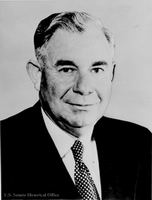Nationality American Name Ernest McFarland | Role Former American senator Preceded by Charles C. Bernstein | |
 | ||
Previous office Senator (AZ) 1941–1953 | ||
Eisenhower et des sénateurs US visitent un camp de rapatriés américains près du Havre
Ernest William McFarland (October 9, 1894 – June 8, 1984) was an American politician and, with Warren Atherton, one of the "Fathers of the G.I. Bill." He is the only Arizonan to serve in the highest office in all three branches of Arizona government, two at the state level, one at the federal level. He was a Democratic Senator from Arizona from 1941 to 1953 (Majority Leader from 1951 to 1953) before he was the tenth governor of Arizona from 1955 to 1959. Finally, McFarland sat as Chief Justice on the Arizona Supreme Court in 1968.
Contents
- Eisenhower et des snateurs US visitent un camp de rapatris amricains prs du Havre
- Early life
- Governor
- Television venture
- Return to law
- Later life
- Legacy
- References
Early life
Born on a farm near Earlsboro, Oklahoma, McFarland attended rural schools and graduated from East Central State Teachers' College, Ada, Oklahoma, in 1914 and from the University of Oklahoma at Norman, in 1917.
During World War I, he served in the United States Navy and nearly died of a bronchial infection. Following surgery by Navy surgeons, he was discharged in 1919 and sent to live in a drier climate. Thus, after the war McFarland moved to Phoenix, Arizona, and was employed as a clerk in a bank. He gathered enough money to pay for tuition and graduated with a law and political science degree from Stanford University in 1921. He moved back to Arizona, passed the bar exam, and commenced practice in Casa Grande. He soon developed an expertise in agricultural and water-use legislation, which would suit Arizona well in the future.
He served as the assistant attorney general of Arizona from 1923 to 1924, county attorney of Pinal County from 1925 to 1930, and judge of the superior court of Pinal County from 1934 to 1940
McFarland entered the US Senate race in 1940. The 28-year Democratic incumbent, Henry F. Ashurst, appeared to be unbeatable and did not launch an aggressive campaign to retain his seat. While Ashurst remained in Washington, D.C., McFarland canvassed the state, giving speeches on water issues and World War II in Europe. By a three-to-one margin, he defeated Ashurst in the primary and went on to win the general election.
McFarland, along with Senator Carl T. Hayden, lobbied for the Central Arizona Project (CAP), aimed at providing Arizona's share of the Colorado River to the state. His efforts failed while he was a senator, but they laid a critical foundation for the late 1960s passage of the CAP.
Not forgetting his veteran roots, McFarland became interested in legislation to benefit veterans returning from World War II. He outlined his proposals before the American Legion in a speech in 1943 and worked to create support for his G.I. Bill with veterans' organizations and members of Congress].
By unanimous votes, Congress approved the bill, and on June 22, 1944, President Franklin Roosevelt signed it into law.
McFarland was easily re-elected in 1946 and served as chairman of a Commerce subcommittee, where he helped plan a postwar role for the US in international communications and rewrote the Communications Act of 1934. After Democratic Majority Leader Scott W. Lucas was defeated in 1950 because of his link with Truman's administration, McFarland's Democratic colleagues chose him as majority leader. He served in that position for two years. In 1952, he was defeated by Barry Goldwater in the national Republican landslide that year, led by Dwight D. Eisenhower.
Governor
McFarland was elected governor of Arizona in 1954 and re-elected in 1956. He worked with members of the Bureau of Reclamation to pick a location for the Glen Canyon Dam and emphasized education during his two terms in office.
Television venture
Shortly after he returned from the Senate, he and several friends formed the Arizona Television Company to start a television station in Phoenix. McFarland had long been intrigued by the still-new medium. In 1955, shortly after he became governor, he opened KTVK, Phoenix's third television station. He chose the call letters "because TV would be our middle name." KTVK was the ABC affiliate for much of Arizona until 1995 and then became one of the nation's most successful independent stations. It remained in the hands of McFarland's family until 1999.
Return to law
McFarland tried unsuccessfully to unseat Goldwater in 1958. After serving as governor, he returned to his law practice and was elected associate justice of the Arizona Supreme Court in 1964. He took part in Miranda v. Arizona and served as Chief Justice in 1968, thus completing a political "grand slam."
Later life
In his mid-seventies, McFarland served as the director of the Federal Home Loan Bank of San Francisco and president of the Arizona Television Company before dying in Phoenix. McFarland is buried in Greenwood/Memory Lawn Mortuary & Cemetery in Phoenix.
Legacy
There is now a monument at the Arizona State Capitol honoring him as the "Father of the G.I. Bill." Also, the McFarland State Historic Park in Florence, Arizona, contains a preserved courthouse and other buildings from when Arizona was just a territory in 1878. McFarland purchased and donated them to the Arizona State Parks Board.
